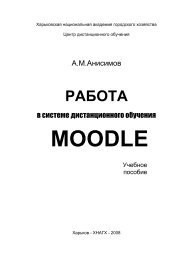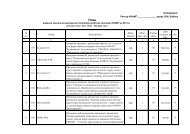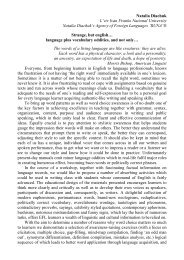міністерство освіти і науки, молоді та спорту україни харківська ...
міністерство освіти і науки, молоді та спорту україни харківська ...
міністерство освіти і науки, молоді та спорту україни харківська ...
You also want an ePaper? Increase the reach of your titles
YUMPU automatically turns print PDFs into web optimized ePapers that Google loves.
craftsmen and workers related to various royal projects. Some of the best preserved<br />
of these are four different workers villages have survived to some extent, all of which<br />
were situated somewhat off of the Nile. The village at Deir el-Medina provides an<br />
idea of the organization of a specialized village, as well as a somewhat distorted view<br />
of village life.<br />
The population of these cities and towns were not urban in a modern sense, but<br />
perhaps more similar to today's provincial Egyptian towns, which have unmistakable<br />
rural aspects to them. The residents consisted not only of urban dwellers, but also of<br />
rural people, such as farmers and herdsmen who went out to the countryside each<br />
day. Urban inhabitants included artisans, scribes, priests, tax-collectors, servants,<br />
guards and soldiers, entertainers and shopkeepers. The kings, nobles and the temples<br />
possessed estates that employed a variety of personnel, many of whom were rural<br />
workers on the agricultural land. These cities and towns certainly had a hierarchical<br />
organization.<br />
1. The passage suggests that:<br />
(A) Agriculture influenced the development of ancient Egypt cities.<br />
(B) Towns and cities were linked with administrative centers.<br />
2. The passage suggests that:<br />
(A) Most housing and public buildings in cities and settlements were made of<br />
mudbrick.<br />
(B) We do not know much about Egyptian cities.<br />
3. The passage suggests that:<br />
(A) The village at Deir el-Medina is the best preserved village.<br />
(B) The cities of ancient Egypt were related to various dynamics that shaped the<br />
course of Egyptian civilization.<br />
4. The passage suggests that:<br />
(A) The kings, nobles and the temples possessed estates.<br />
(B) The population of these cities and towns were not urban in a modern sense.<br />
24

















